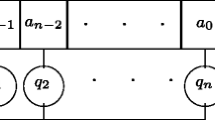Abstract
Binary feedback shift registers, with applications to reliable communications, stream cipher cryptography, radar signal design, pseudorandom number generation, digital wireless telephony, and many other areas, have been studied for more than half a century. The maximum-length binary linear feedback shift registers, called m-sequences or PN sequences, are the best-known and most thoroughly understood special case.
The m-sequences have several important randomness properties, and are known as pseudo-random sequences. They are characterized by the cycle-and-add property, whereby the term-by-term sum of two cyclic shifts is a third cyclic shift. Along with other families of binary sequences that correspond to cyclic Hadamard difference sets, they have the two-level autocorrelation property. The m-sequences share the span-n property (all subsequences of length n, except n zeroes, occur in each period of length 2n –1) with a far larger class of nonlinear shift register sequences. No counterexample has been found to the conjecture that only the m-sequences have both the two-level autocorrelation and the span-n properties.
The class of m-sequences is too small, and has too many regularities, to provide useful cryptographic security as key sequences for stream ciphers. For this purpose, nonlinear shift register sequences which have large linear span and a sufficiently high degree of correlation immunity may be employed.
Preview
Unable to display preview. Download preview PDF.
Similar content being viewed by others
References
Golomb, S.W.: Shift Register Sequences. Holden-Day, Inc., San Francisco (1967); Revised 2nd edn., Aegean Park Press, Laguna Hills, CA (1982)
Radar, S.W.G., Gong, G.: Signal Design for Good Correlation, for Wireless Communication, Cryptography. Cambridge University Press, Cambridge (2005)
Author information
Authors and Affiliations
Editor information
Editors and Affiliations
Rights and permissions
Copyright information
© 2006 Springer-Verlag Berlin Heidelberg
About this paper
Cite this paper
Golomb, S.W. (2006). Shift Register Sequences – A Retrospective Account. In: Gong, G., Helleseth, T., Song, HY., Yang, K. (eds) Sequences and Their Applications – SETA 2006. SETA 2006. Lecture Notes in Computer Science, vol 4086. Springer, Berlin, Heidelberg. https://doi.org/10.1007/11863854_1
Download citation
DOI: https://doi.org/10.1007/11863854_1
Publisher Name: Springer, Berlin, Heidelberg
Print ISBN: 978-3-540-44523-4
Online ISBN: 978-3-540-44524-1
eBook Packages: Computer ScienceComputer Science (R0)




